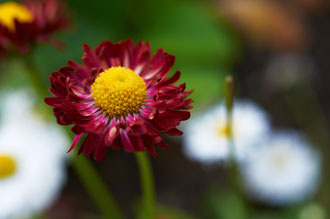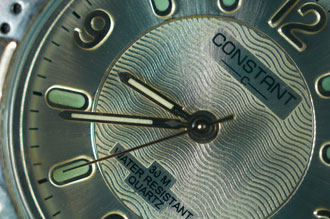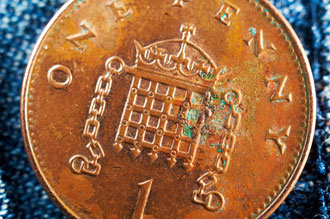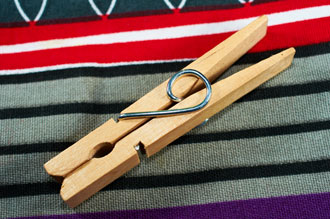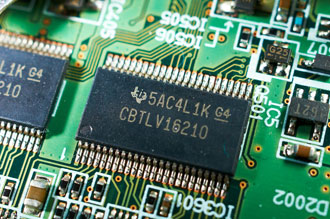Tokina AT-X M35 Pro DX 35mm f/2.8 Macro
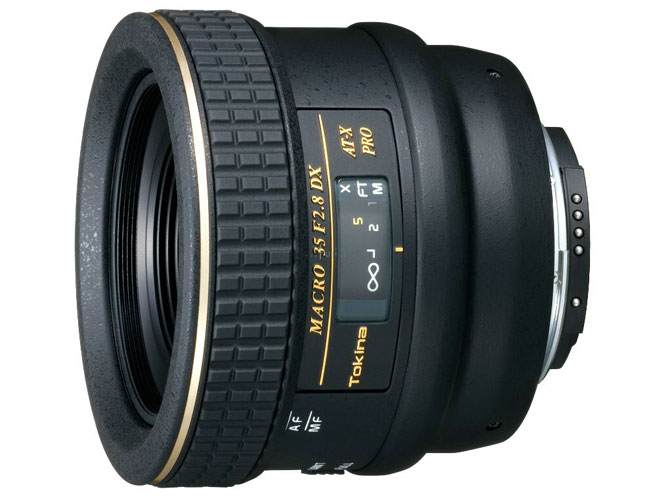
Available to fit Canon and Nikon DSLR cameras with an APS-C sized sensor, this 35mm f/2.8 Macro lens from Tokina is currently unique as neither manufacturer produces a macro lens at this focal length.
Priced at £370, this lens offers a compact and lightweight solution for those looking for an introduction to macro photography.
Tokina AT-X M35 Pro DX 35mm f/2.8 Macro Lens: Handling and features
At only 60mm long when focused to infinity, this lens is small enough to stow away in the bottom of a kit bag until it is needed, and weighing only 340g, it is very lightweight too. Despite the light weight, it feels very sturdy and the front element is deeply recessed inside the lens, protecting it from any bumps and scrapes. The textured black finish gives the lens a very high quality appearance, which compliments the Nikon D300 used for testing perfectly.
Pulling the manual focus ring towards the camera instantly switches from auto focus to manual focusing, which although not as elegant a solution as full time manual over ride, it still works well. In use the manual focus ring is nicely damped, making it easy to make fine adjustments quickly. A standard built in motor powers the auto focus mechanism and at normal distances, focus speeds are adequate. A focus limiter switch is provided to prevent the lens from tracking through the entire focus range, which can help to speed up focusing in difficult situations.
Focus isn't performed internally, and the lens extends by a couple of centimetres at minimum focus. Due to the short 35mm focal length, working distances can be tight, and it can be difficult to get enough light on your subject, especially at maximum magnification. The lens accepts 52mm filters and the lens barrel does not rotate during focusing, making it straightforward to use polarising and graduated filters.
Tokina AT-X M35 Pro DX 35mm f/2.8 Macro Lens: Performance
Shooting wide open the performance across the frame is already excellent. Stopping the lens down to f/4 increases the sharpness in the centre to outstanding levels and the quality towards the edges remains close to excellent. Stopping the lens down any further reduces sharpness due to diffraction, but sharpness levels remain very good right down to f/16.
| Resolution at 35mm | How to read our graphsThe blue column represents readings from the centre of the picture frame at the various apertures and the green is from the edges. Averaging them out gives the red weighted column.The scale on the left side is an indication of actual image resolution. The taller the column, the better the lens performance. Simple. For this review, the lens was tested on an Nikon D300 using Imatest. | |
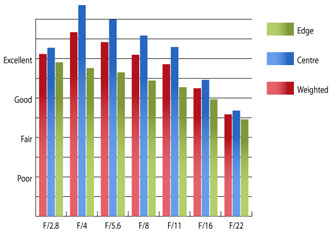 |
Levels of chromatic aberrations towards the edges of the frame are higher than I would normally expect from a macro lens, and this phenomenon appears to get worse as the lens is stopped down. At f/22 coloured fringing towards the edge of the frame exceeds 2.5 pixel widths, which may pose issues along high contrast edges, especially at large print sizes.
| Chromatic Aberrations at 35mm | How to read our chartsChromatic aberration is the lens' inability to focus on the sensor or film all colours of visible light at the same point. Severe chromatic aberration gives a noticeable fringing or a halo effect around sharp edges within the picture. It can be cured in software.Apochromatic lenses have special lens elements (aspheric, extra-low dispersion etc) to minimize the problem, hence they usually cost more. For this review, the lens was tested on an Nikon D300 using Imatest. | |
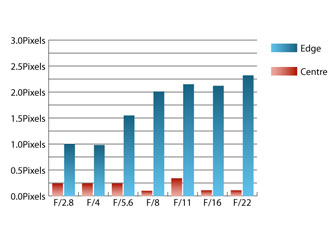 |
Falloff of illumination towards the corners of the frame is very well controlled. At f/2.8 the corners are only 0.85stops darker than the image centre, and stopping down to f.4 results in visually uniform illumination.
Slightly more barrel distortion than I'd normally expect from a fixed macro lens is present. Imatest detected 1.1% barrel distortion, which shouldn't pose too many issues. If straight lines are paramount, the distortion should be easy enough to correct in image editing software as the pattern is uniform across the frame.
The recessed front element is already well protected from extraneous light that may cause flare or loss of contrast, but for a little extra protection, a round metal lens hood can be screwed into the front filter thread. When shooting into the light, I did not notice any flare, but contrast can drop dramatically, especially if the light source is very strong.
Tokina AT-X M35 Pro DX 35mm f/2.8 Macro Lens: Verdict
Overall this Tokina makes for a compelling choice, especially for those looking for a lightweight macro optic on a budget, for applications where the short working distance won't be an issue.
Optically, this lens is a superb performer, yielding sharp, contrasty images, even when shooting with the aperture wide open. Its only weaknesses are the levels of chromatic fringing towards the edges of the frame, and its tendency to lose contrast when shooting into the light. Saying that, for the price, the performance is still superb.
Tokina AT-X M35 Pro DX 35mm f/2.8 Macro Lens: Pros
 Excellent sharpness across the frame
Excellent sharpness across the frame Good build quality
Good build quality Compact
Compact Lightweight
Lightweight Keenly priced
Keenly pricedTokina AT-X M35 Pro DX 35mm f/2.8 Macro Lens: Cons
 Chromatic aberrations towards the edge of the frame when stopped down
Chromatic aberrations towards the edge of the frame when stopped down Loss of contrast when shooting into the light
Loss of contrast when shooting into the light | FEATURES |  |
| HANDLING |  |
| PERFORMANCE |  |
| VALUE FOR MONEY |  |
| OVERALL |  |
Tokina AT-X M35 Pro DX 35mm f/2.8 Macro Lens: Specification
| Price | £370.00 |
| Contact | www.kenro.co.uk |
| Filter size | 52mm |
| Format | APS-C |
| Construction | 9 elements in 9 groups |
| Angle-of-view | 43° |
| 35mm equivalent focal length (on APS-C body) | 52.5mm |
| Internal focusing | No |
| Image stabilisation | No |
| Minimum focus | 14cm |
| Maximum aperture | f/2.8 |
| Minimum aperture | f/22 |
| Weight | 340g |
| Size (lxw) | 73.2mm x 60.4mm |
| In the box | Metal lens hood |
Add your message
Login required
Please login here or if you've not registered, you can register here. Registering is safe, quick and free.
Please login here or if you've not registered, you can register here. Registering is safe, quick and free.
photodo Stats
1102 lenses
428 MTF tests
74 in-depth photodo reviews
100+ users join each day
Help the lens community by reviewing or rating a lens today via our lens search
428 MTF tests
74 in-depth photodo reviews
100+ users join each day
Help the lens community by reviewing or rating a lens today via our lens search
Latest Lens Reviews
- Chinon 28mm f/2.8 Vintage Lens Review
- Canon EF 70-200mm f/4L IS II USM Lens Review
- Samyang AF 85mm f/1.4 EF Review
- Sigma 70mm f/2.8 DG Macro Art Review
- Samyang AF 24mm f/2.8 FE Review
- Meike 50mm f/1.7 Review
- Tamron 70-210mm f/4 Di VC USD Review
- Lensbaby Burnside 35mm f/2.8 Review
- Asahi Super Takumar 50mm f/1.4 Review
- Asahi Super-Multi-Coated Takumar 135mm f/3.5 Review
